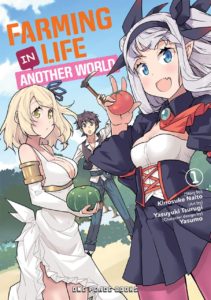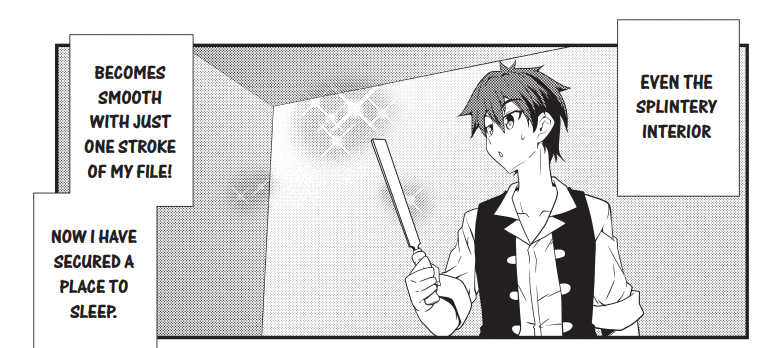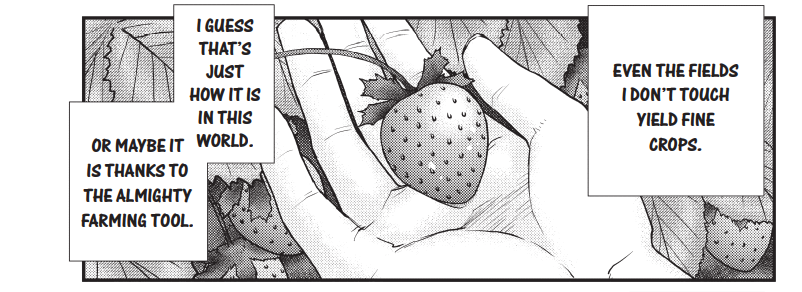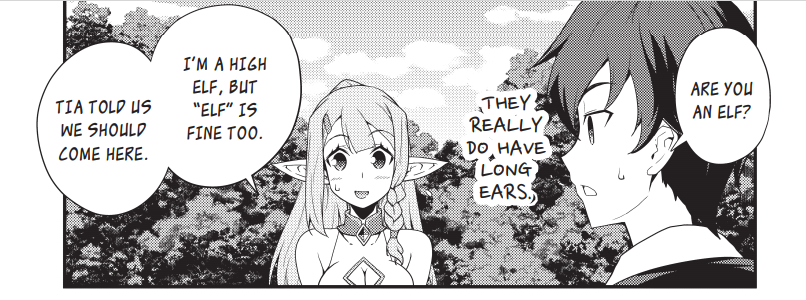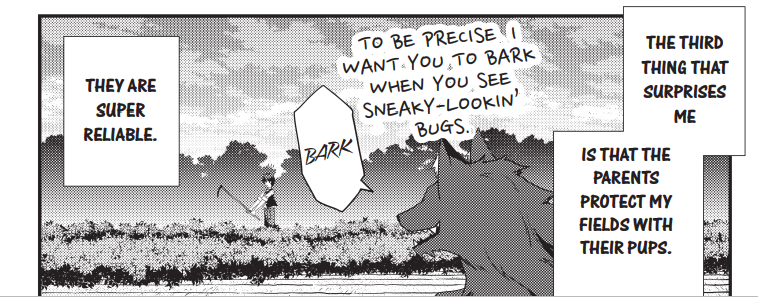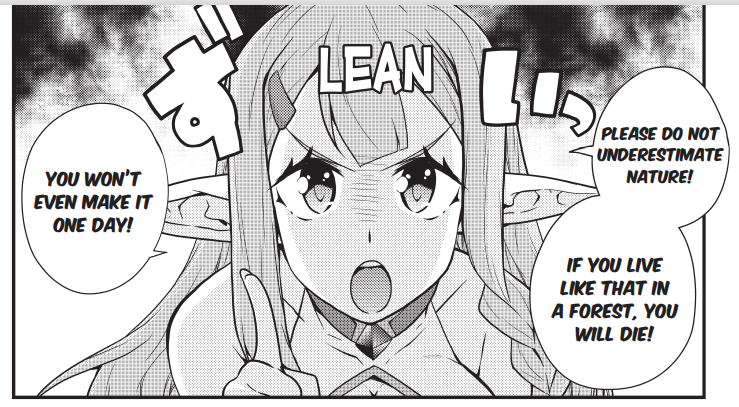Cultivate an Interest in Isekai Farming
While the traditional Japanese literary concept of living a lifetime in another world may date back to the Japanese Urashima Taro fairy tale, the modern provision of the concept arose within anime in 1983 and has steadily become more entrenched, prolific, and diverse. Author Naito Kinosuke cultivated a unique breed of the “isekai” concept in 2016 with the premiere of the light novel series A Leisurely Farmer in Another World (Isekai Nonbiri Nouka). The pleasant, innocuous story quickly gained popularity and spawned a manga adaptation in 2018. One Peace Books is now bringing the popular manga adaptation to American readers with an authorized English translation. The first volume introduces the setting and scenario, founding cast, and the story’s quirky amiable tone.
The story revolves around Japanese salaryman and middle-aged invalid Hiraku Machio. After dying unceremoniously at age 39, a mysterious god-like being resurrects Hiraku in a younger, heartier body in a primeval forest, giving him only a set of clothing and a single magical farming tool. Hiraku then sets to carving out a life for himself, literally, by tilling the land, felling trees to construct rudimentary buildings, and eventually giving rise to a makeshift rural farming village. The story is obviously aware of its well-worn genre roots. After all, the first chapter is titled, “Typical Relocation to Another World.” Yet the story manages to work around strict redundancy. “Isekai Farming” varies slightly from other familiar titles that also star reincarnated protagonists. Kazuma in author Jitakukeibihei’s Kono Subarashii Sekai ni Shukufuku o! is reincarnated in his original body at his same age. Satoru in author Fuse’s Tensei Shitara Suraimu Datta Ken is resurrected as a different species. The protagonists of Knight’s & Magic and Kenja no Mago are conventionally reincarnated as newborn infants in their new worlds. Hiraku Machio, however, is directly reincarnated as a healthy, full grown young adult version of himself. However, that’s not to say that the story doesn’t fall back onto familiar isekai tropes. Although “Isekai Farmer” isn’t an action/adventure story, it still depicts a protagonist reincarnated with superhuman “cheats.” And it’s largely from this particular scenario that much of the story’s absurdist humor grows.
Per his own request, Hiraku is reincarnated with a body highly resistant to normal human weaknesses including fatigue, exhaustion, hunger, and sickness. Moreover, seemingly as a result of his literally charmed existence, the difficulties of agricultural frontier life are magically simplified for him. This story is no Dr. Stone, in which the protagonist has to struggle to scrape together every aspect of survival. Rather than need to hunt for sustenance, wild animals hurl themselves at Hiraku so that he might easily slaughter them. Merely by turning the soil and wishing, whatever crops Hiraku desires magically mature. He doesn’t need to worry about voracious insects because miraculously plain water functions as a totally effective insecticide for him. Despite having been an metropolitan office worker in his previous life, and despite repeatedly claiming that he doesn’t have the skill or knowledge to craft rustic accoutrements, Hiraku seems to be able to carve, build, or craft a functionally sufficient version of anything he needs on his first try. Wild animals spontaneously become tame, domesticated pets after coming into contact with him. Even shortly after Hiraku privately aspires for a wife, not only does a buxom nubile woman appear, in short order Hiraku finds himself bestowed with an entire literal harem of attractive fantasy race women.
In effect, the story starts out as a subdued parody but rather quickly reveals itself to be a domestic absurdist comedy. Early plot points seem mysterious and potentially foreshadowing of future story development. But they’re probably not. The “god” figure suggests that reincarnating Hiraku is a self-serving gesture, implying that possibly in the future Hiraku will be revealed as a small piece in a larger machination among gods. But then the story seems to undermine that possibility. The god figure suggests that he has a divine plan for Hiraku but then allows Hiraku to dictate every aspect of the reincarnation as though there never was any predetermined plan in the first place. The god figure endows Hiraku with a magical tool embedded into Hiraku’s very identity yet oddly encourages Hiraku to keep the tool safe, as if it can somehow be lost or damaged. But the plot implication appears to be just an irrelevant platitude rather than a suggestion of a looming plot thread. Once Hiraku’s new life begins, even more unexplained and arbitrary situations arise. Hiraku spends weeks inside his one-room domicile during winter, but the story doesn’t explain what he does to stave away boredom. A pack of migratory elves have spent 200 years searching for a place to settle down yet haven’t located a suitable place yet despite all of the surrounding land being uninhabited and available. Moreover, disparate branches of the elf tribe have been traveling around the same land for 200 years yet haven’t ever managed to find each other. Effectively, select revelations including wild animals having remarkably human intellects eventually reveal that the story is just too unbelievable and absurd to be anything besides a fantasy slice-of-life comedy rather than a fantasy drama.
The execution of the manga likewise reinforces the interpretation that “Isekai Farmer” is a fantasy comedy rather than a fantasy drama. Illustrator Yasuyuki Tsurugi’s manga art, based on Yasumo’s original novel illustration character designs, are remarkably anime-esque, showing no trace of the rough, tough hardship associated with farming life. Hiraku starts his agricultural life with one set of clothes, yet despite months of hard outdoor labor, his clothes never exhibit any fraying. Occasionally the visual art lacks proper perspective. Most notably, Hiraku describes the monster rabbits as “huge,” and states that just one provides enough meat to last five days. Yet the rabbit is illustrated at the size of an ordinary garden rabbit. Otherwise the visual art is entirely sufficient, although not elaborate. Background art is minimal and typically limited to just forestation.
One Peace Book’s script translation is free of errors and typos. With one exception, the script doesn’t reference Japanese honorables, so suffixes don’t need translation. Sound effects are translated in-frame, although in one instance the translation is partially superimposed over the original art. The story does include some subtle and prominent references to Japanese culture that aren’t extensively defined, including the salaryman “death march” and bowing to express gratitude even when alone, and summarily defined references to “zabuton” and “Hanasaka Jiisan.” But these passing references are minor and easily brushed by. The story includes male and female nudity, but depictions are censored and non-graphic. The script contains no offensive language although it does contain some comedic sexual innuendo. The story’s first four pages, originally published in color during the magazine serialization, are rendered in monochrome for the collected volume. The 168-page book contains the manga’s first 16 chapters, a single-page postscript, and a four-page bonus prose story by original author Naito Kinosuke.
The first volume of Yasuyuki Tsurugi’s Farming Life in Another World manga adaptation is a breezy, enjoyable distraction. It doesn’t take itself seriously in the least and, as a result, provides some amusing entertainment. The manga can be easily described as a cousin to Riichiro Inagaki & Boichi’s manga Dr. Stone, although without any of the drama, tension, or action, a less instructive version of Hiromu Arakawa’s Gin no Saji (“Silver Spoon”), or a parallel to Atto’s Non Non Biyori starring a young adult man rather than preadolescent girls. Farming Life in Another World also feels a lot like an even more lighthearted and whimsical sibling to That Time I Got Reincarnated as a Slime. One Peace Books will release the first volume of the Farming Life in Another World manga in print and digital formats on October 28.
For transparency sake, One Peace Books provided me a PDF review copy of the first volume, and no other incentive, suggestion, or request.
